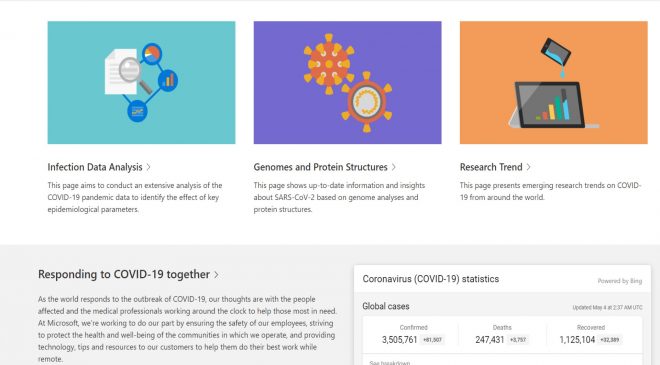
Website is intended to be a resource for those interested in analysing data related to the pandemic
With the COVID-19 pandemic continuing to impact communities around the world, researchers everywhere are fighting hard in the hopes of gradually understanding the mystery of the COVID-19 virus through the most advanced technologies available.
Researchers from Microsoft Research Asia using their expertise and research experience in the fields of computational biology and data analytics, have built a COVID-19 Insights website. The site will be used as a resource for those interested in analysing data related to the pandemic.
The COVID Insights website consists of three major sections:
- Infection Data Analysis
- Genomes and Protein Structures
- Research Trends.
It visually and interactively displays the pandemic trends in different countries and regions; the virologic analysis of the virus that causes the disease, SARS-CoV-2; and global research focuses.
All data used on the website is taken from publicly available sources, including from Johns Hopkins University; US Centres for Disease Control and Prevention; and the Global Initiative on Sharing All Influenza Data (GISAID.
Leveraging the public data, Microsoft researchers use advanced technology to discover patterns and insights to further expand thinking on the pandemic.
So far the “Infection Data Analysis” page presents cross-country/region comparisons of transmission dynamics. For example, through analysis, researchers found that the data trend in Germany from February 27 to March 14 closely resembled the data trend in South Korea from February 18 to March 5, and so the containment measures taken in South Korea after March 5 can serve as a more accurate reference for Germany in mid-March.
Here, researchers represented the COVID-19 time-series data in a low-dimensional Euclidean space. For a specific region and time interval, researchers used a vector in this space to reflect data trend, which allows them to discover similarities in pandemic trends between certain countries or regions at certain time periods, thereby finding a suitable object of reference.
In addition, based on open-source data from four different regions, the page provides a unified view of data analysis on high-risk activities associated with COVID-19, making it easy to compare transmission data differences among regions.
For example, crowd gathering is the most distributed high-risk activity in France, while “international travel” is the leading high-risk activity in Singapore.
Researchers have mapped unstructured case descriptions to the unified activity distribution for visualisation, which effectively solves this challenge. Attribution analysis of high-risk activities, especially different attribution results from different regions, can help provide a personalized reference for infection prevention.
The researchers behind the website hope that COVID Insights can help visitors understand the pandemic in a scientific way, through in-depth analysis and the mining of insights from pandemic data.
“We hope that more AI researchers, data scientists, and computational biologists will continue to work together to jointly accelerate the progress of scientific research and overcome the pandemic as soon as possible,” the researchers stated.




